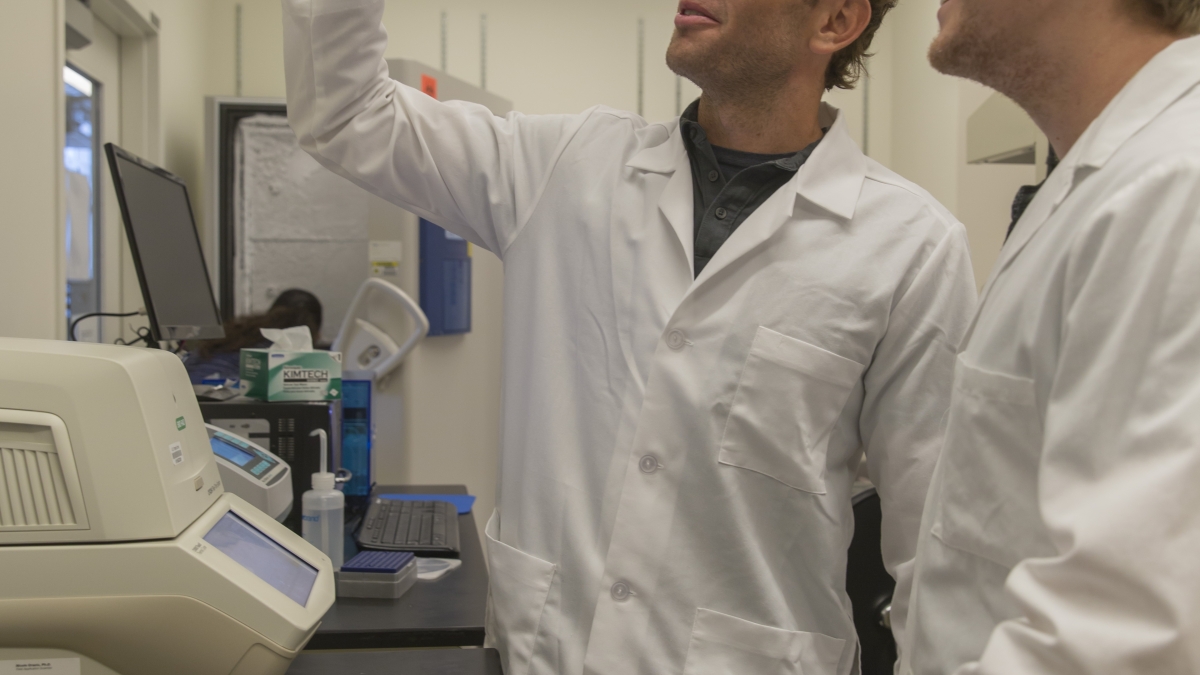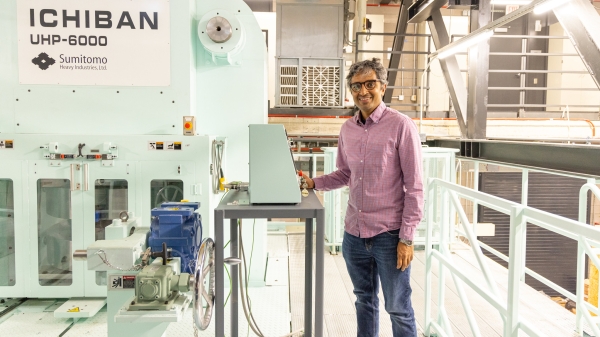When aging goes wrong: Researchers try to identify causes of Alzheimer’s

David Brafman (left) and Nick Brookhouser examining a plate used in an assay to characterize the identity of the hiPSC-derived neurons used in their research. Photo by Jessica Hochreiter/ASU
In the search for treatments of Alzheimer’s disease, researchers are now looking for new approaches to understand how the progressive disease starts so they can better put a stop to it.
David Brafman, an assistant professor of biomedical engineering at Arizona State University’s Ira A. Fulton Schools of Engineering, partnered with Mayo Clinic’s Dr. Richard J. Caselli to use a stem-cell-based approach to identify causes of Alzheimer’s disease in people with various levels of risk based on variations of the apolipoprotein E (ApoE) gene.
Brafman uses cells from patients with different genetic risk factors for Alzheimer’s disease and creates living brain cell models to examine a variety of neuronal pathways and cellular mechanisms that may relate to how Alzheimer’s disease begins.
Brafman and Caselli received a $408,540, two-year grant by the National Institute on Aging, part of the National Institutes of Health, for their project “Generation and characterization of isogenic hiPSC lines with various ApoE genotypes.”
Human-induced pluripotent stem cells, or hiPSC, technology makes it possible to obtain a fully differentiated cell type, such as a blood cell, from a patient with a specific disease and reprogram it back into a pluripotent stem cell — a cell type that is capable of differentiating into all of the cell types of the mature, adult body.
As it relates to this project, Brafman uses this technology to take white blood cells, provided by the Caselli laboratory, from both patients with Alzheimer’s and people that are healthy and transform them into hiPSCs. In turn, these hiPSCs are able to differentiate into the various cell types that comprise the brain.
“Having living brain cells gives him the ability to study cellular mechanisms that could not otherwise be studied in either living or deceased people,” Caselli said.
Brafman says the various cell types that are able to be generated from the hiPSCs derived from patients with Alzheimer’s disease are a rare and valuable resource, especially those with specific genetic risk factors.
“We were fortunate enough to receive funding via the ASU-Mayo Seed Grant mechanism to perform the first, and arguably riskiest aspect, of this research, which was to generate hiPSC lines directly from patient samples,” Brafman said. “In collaboration with the Caselli laboratory, we generated a comprehensive library of hiPSC lines from patients with different ApoE genotypes.”
Brafman believes the NIH was impressed by the immense amount of preliminary data that they had gathered, which would not have been possible without the funding provided by the ASU-Mayo Seed Grant.
The hiPSC lines also have relevance to research outside of the scope of Brafman and Caselli’s project.
“These lines have been valuable not only for our research but also the research of numerous collaborators that we have freely shared these lines,” Brafman said.
The ASU-Mayo Clinic team hopes their use of hiPSC lines will advance the study and creation of treatments for Alzheimer’s disease.
“Ultimately, we hope to discover key insights that lead to an effective therapy for Alzheimer’s disease,” Caselli said. “No one approach seems to have cornered the market so the greater the number of approaches we can bring to bear on this subject the greater the chance for success.”
More Science and technology

Securing the wireless spectrum
The number of devices using wireless communications networks for telephone calls, texting, data and more has grown from 336…

New interactive game educates children on heat safety
Ask A Biologist, a long-running K–12 educational outreach effort by the School of Life Sciences at Arizona State University, has…

Unlocking Earth's origins
Looking up at a vast, star-studded sky, people have always wondered: Are we alone in this universe? It’s a fundamental question…